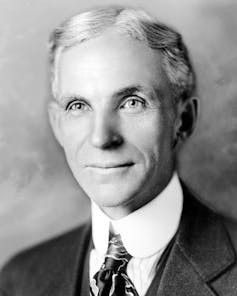HÂţ» the author: is Associate Professor of Sociology and Social Anthropology at HÂţ» University and Canada Research Chair in Sustainable Rural Futures for Atlantic Canada.
Like any crisis, the COVID-19 pandemic is an opportunity to rethink how we do things.
As we near the 100-day mark since the pandemic was declared, one area getting a significant attention is the workplace, where a window is opening for good ideas to move from the fringes to the mainstream.
For example, when started working from home, many businesses were forced to experiment with telecommuting. Interestingly, after the pandemic passes, because it benefits employers and employees alike.
Another idea, less widely tested than telecommuting, is generating buzz: the four-day work week. New Zealand Prime Minister Jacinda Ardern as a way to divvy up jobs, encourage local tourism, help with work-life balance and increase productivity.
As a sociologist who teaches about work and wrote , I believe she’s right.
Not a compressed schedule
A four-day work week must not be confused with a compressed schedule that has workers squeeze 37.5 to 40 hours of work into four days instead of five. For reasons that should be clearer below, that won’t help us now.
A true four-day workweek entails full-timers clocking about 30 hours instead of 40. There are many reasons why this is appealing today: families are in the absence of daycares and schools; workplaces are trying to reduce the number of employees congregating in offices each day; and .
A shorter work week could allow parents to cobble together child care, allow workplaces to stagger attendance and, theoretically, allow the available work to be divided among more people who need employment.
Read more:
The most progressive shorter work week entails no salary reductions. This sounds crazy, but it rests on peer-reviewed research into shorter work weeks, which finds , because they waste less time and are better-rested.

Shorter work weeks reduce the number of sick days taken, and on their extra day off, employees don’t use the office’s toilet paper or utilities, reducing their employer’s costs. Therefore, while it is counter-intuitive, it’s possible for people to work less at the same salary while . That people might have to spend more of their own money on toilet paper is a concession most workers would probably accept.
The same body of research also has more predictable findings: .
Entrenched morality of work
If it makes this much sense, why don’t we have a four-day week already? It turns out this question is more than 150 years old.
Some of the answer pertains to the logistics involved in transforming our whole system of work, that’s not the entire answer. After all, the work week , so it can technically be done again.
The rest of the reason is rooted in capitalism and class struggle.
Thinkers from Paul Lafargue (“,” first published in 1883) to Bertrand Russell (“,” from 1932) and Kathi Weeks (“,” from 2012) have concluded we resist worktime reductions in the face of supportive evidence — and our own desires for more leisure — because of the entrenched morality of work and the resistance on the part of “the rich” to “the idea that the poor should have leisure,” in Russell’s words.
We are extremely attached to the idea that hard work is virtuous, idle hands are dangerous and people with more free time can’t be trusted.
Four-day work weeks floated in the 1930s
Nobody is suggesting evil governments conspire with evil bosses to keep powerless people busy. As historian has shown, there was significant interest in shorter work hours in the 1920s and 30s, when the 30-hour week was touted as a way to “share” the work among the Great Depression’s unemployed and underemployed citizens.

Even industrialists W. K. Kellogg and Henry Ford supported a six-hour day because they believed more rest would make for more productive workers. But Hunnicutt’s research in reveals that some employers cut wages when they cut work hours, and when employees fought back, they dropped their demands for shorter work hours and focused instead on wage increases.
In the complex push and pull of capitalism, eventually even the New Deal, , shifted away from its early demands for more leisure toward demands for more work.
It’s quite possible we will do the same in our COVID-19 moment, and five days a week when this is all over.
But we have new reasons for considering shorter work weeks, and they might be more widely persuasive. It is also possible that we have finally given up on the that working longer will translate into better lives. The four-day work week could be another wild idea that makes it through the pandemic’s open policy window.![]()
which features includes relevant and informed articles written by researchers and academics in their areas of expertise and edited by experienced journalists.
HÂţ» University is a founding partner of The Conversation Canada, an online media outlet providing independent, high-quality explanatory journalism. Originally established in Australia in 2011, it has had more than 85 commissioning editors and 30,000-plus academics register as contributors. A full list of articles written by HÂţ» academics can be found onÂ

